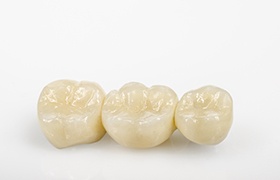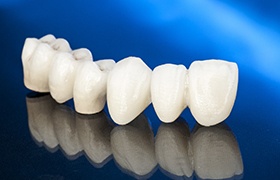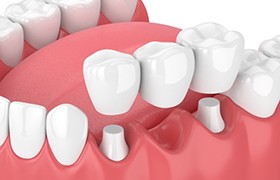
Dental Bridges Aurora
Rebuild Your Smile with a Dental Bridge
Teeth are meant to last for a lifetime, but that isn’t a reality for many adults. Studies show at least 120 million Americans have lost one or more teeth. Traditionally, a bridge fills the space of a single tooth or consecutive missing teeth. All-ceramic material is used to replace the portions of the teeth visible above the gum line. Our office uses the latest techniques and technologies to create high-quality dental bridges in Aurora. This restores a beautiful, complete smile while allowing you to chew your favorite foods again, like steak.
Why Choose Mauck and Ricci, DDS for Dental Bridges?
- Modern dental care through continued training.
- Advanced technologies for precise results.
- High-quality material for a natural-looking smile.
What is a Dental Bridge?

A conventional dental bridge has been used for decades to treat consecutive tooth loss. It relies on abutment teeth on either side of the gap to support it. Believe it or not, not all bridges are the same. We’ll recommend which type is right for you depending on your specific needs:
- Cantilever Bridge: The bridge relies on only 1 abutment tooth for support.
- Bonded Bridge: Dental crowns are affixed to the adjacent teeth to hold the bridge in place.
- Implant-Retained Bridge: 1-2 titanium implant posts are surgically placed into the jawbone to act as tooth roots to anchor the bridge.
No matter the method you choose, you can chew, smile, and speak with confidence knowing your bridge looks natural. We’ll preserve your remaining teeth and improve your quality of life using a personalized treatment plan.
What are the Benefits of Dental Bridges?

Losing even a single tooth can have devastating consequences for your self-esteem, oral health, and your daily life. It’s best to replace your missing teeth as soon as possible to prevent any additional complications. A traditional fixed bridge is a popular solution because it offers a variety of benefits, including:
- Easy maintenance and care.
- Supports your natural teeth to prevent dental drift.
- Durable to withstand the pressure of regular chewing.
- Long-term solution that can last for 10 years or longer with the right aftercare.
An Implant-retained bridge offers more benefits than the traditional method because they mimic everything from the root up. As a result, you’ll enjoy a nearly perfect replica of your natural smile that has the potential to last for a lifetime.
Am I a Candidate for a Dental Bridge?

If you’ve lost a tooth or two over the years, you might be a candidate for a dental bridge. You’ll need an initial consultation to evaluate your oral health and discuss the results you want to achieve to determine which treatment plan best meets your needs.
How Much Do Dental Bridges Cost?

There isn’t a set fee for dental bridges because the cost is based on your specific plan, such as the number of teeth you’re treating. A member of our team will work on your behalf with your dental insurance carrier to maximize your benefits. If there’s any remaining expense, we offer several payment solutions to keep your new smile affordable.
If you’re ready to enjoy a complete smile again, contact our office today to schedule your consultation.
Dental Bridge FAQs

These days, you have plenty of options available to bring back your missing teeth. If the lost teeth are consecutive, many patients find that a dental bridge is the ideal solution to fill the gap. However, you may still have questions about the treatment process. Below, you’ll find the answers to some questions regarding bridges that your dentist in Aurora gets asked the most often.
How Long Does It Take to Get a Dental Bridge?
Typically, it takes a few weeks to receive a traditional dental bridge. After preparing your abutment teeth to support the bridge, we take impressions of your mouth and send them to a dental lab. We’ll place a temporary bridge to protect your teeth in the meantime. Once the permanent bridge arrives at our office, we’ll have you come in for a second appointment so that we can remove your temporary and seat your final bridge into place.
The process of getting an implant bridge takes longer. First, you’ll have to ensure that your jaw is healthy enough to accommodate dental implants in Aurora. Then, you’ll have to undergo surgery and wait three to six months for the implant posts to fuse with your jaw before your bridge can be installed. That said, the longevity that implant bridges offer makes them worth the wait.
Does Getting a Dental Bridge Hurt?
Preparing your natural teeth to secure a bridge generally involves removing some enamel, but we’ll numb your mouth beforehand so that you don’t feel pain. After that appointment, though (and after placing your bridge), you may experience some minor soreness and sensitivity, but it should only last for a couple of days at most.
The dental implant surgery may leave your mouth feeling sore for a few days afterward, but you should be prescribed pain medication to help. After that, placing your bridge atop your implants shouldn’t cause discomfort.
Do Dental Bridges Require Any Special Care?
For the most part, traditional and implant bridges can be cared for in the same way as natural teeth. You’ll want to brush them twice a day for two minutes each time. Avoid chewing particularly hard or sticky foods to avoid fracturing or loosening your bridge.
The only difference would be cleaning the area between your bridge and your gums. We can recommend oral hygiene products, like water flossers or interdental brushes, that can prevent plaque from building up in that area.
How Many Teeth Can a Dental Bridge Replace?
Theoretically, a dental bridge could replace any number of missing teeth. However, dentists tend to limit bridges to replacing three or fewer teeth. That bridge would require five units to stay in place. After that point, the likelihood of the restoration experiencing complications or even failure increases significantly.